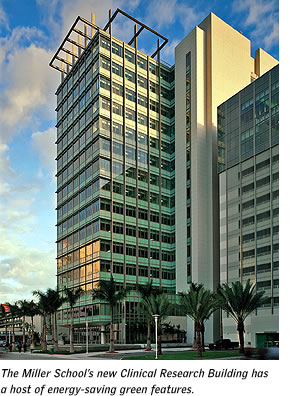 Miller School faculty and staff will soon be recycling
even more plastic, paper, and glass and walking through
courtyards
with native vegetation. Some will even be flushing with
recycled water. It’s all part of the plan to embrace
Green U, a campus-wide program designed to help make the
University more environmentally responsible. Miller School faculty and staff will soon be recycling
even more plastic, paper, and glass and walking through
courtyards
with native vegetation. Some will even be flushing with
recycled water. It’s all part of the plan to embrace
Green U, a campus-wide program designed to help make the
University more environmentally responsible.
Working with the nonprofit organization
Green Seal, the University is seeking to achieve certification
as a business
operating in a sustainable manner.
“We learned we have to do a better job with recycling,” says
Ken Capezzuto, director of Environmental Health and Safety
at the University. “That means we have to make recycling
easily available for everyone. Those are things we can
do right away.”
At a meeting on the Coral Gables campus,
it became clear that the biggest challenge lies in educating
employees
and students. The rest is making recycling convenient
for people. “If they see it, they will be more likely
to do it. If they don’t, -forget it,” says
Denis Hector, associate dean of the School of Architecture.
The Miller School campus is actually ahead of the Gables
campus in recycling paper, mostly because of requirements
to comply with HIPAA privacy regulations.
Other issues are already being addressed.
Cleaning services at the Miller School already use green-certified
cleaning
products that are more environmentally friendly and less
toxic. “We do not use anything chlorine-based,” Capezzuto
says. “Other products can still disinfect without
the hazard of using chlorine.” In addition, campus
vacuum cleaners are fitted with HEPA filters for more efficient
and cleaner air exhaust.
The Miller School has begun building environmentally
sensitive features into recent construction projects.
The Clinical
Research Building, for example, derives much of its light
from natural sources, reducing the need for electricity.
The huge windows in the Medical Wellness Center, located
on the top floor of the CRB, offer more than an amazing
view of downtown Miami—they provide a great source
of natural light. The facility is considered a “green
building.”
Future building plans call for a real
commitment to the Green U principles. The Biomedical
Research Institute,
currently under construction, will feature several components
designed to provide better energy efficiency. Condensation
from air conditioning units in the top floors, for instance,
will be collected and used to flush toilets in bathrooms
in the bottom four floors of the building.
The institute is the first University
building to be registered with the United States Green
Building Council for LEED
(Leadership in Energy and Environmental Design) certification.
Construction plans for all future buildings
will incorporate features to improve efficiency and save
on electricity
and other costly components.
It will cost more in the beginning, Capezzuto
says, but the University will enjoy increased savings
in reduced
fuel expenses, enhanced occupant comfort and health,
and even extended building life. |